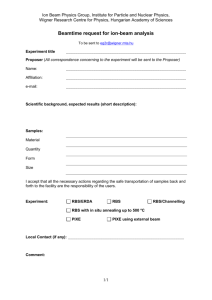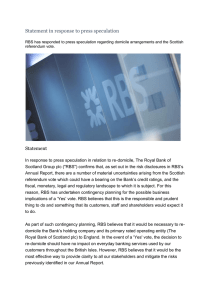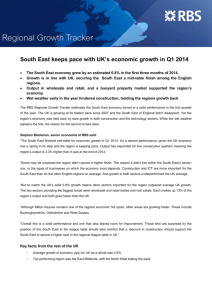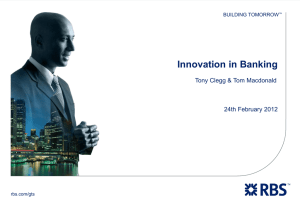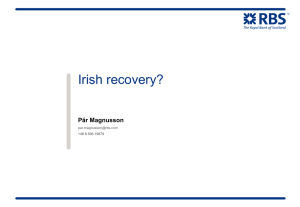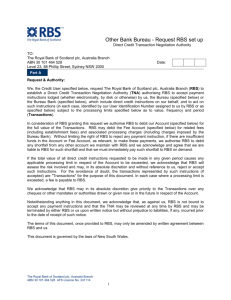File
advertisement
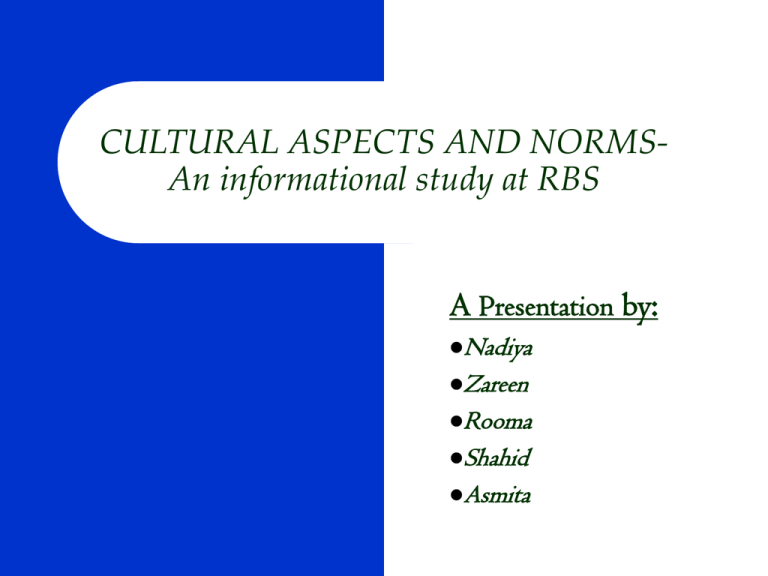
CULTURAL ASPECTS AND NORMSAn informational study at RBS A Presentation by: Nadiya Zareen Rooma Shahid Asmita ORGANIZATIONAL CULTURE…….. What do we mean by that……….??? Basically, organizational culture is the personality of the organization. Culture is comprised of the assumptions, values, norms and tangible signs (artifacts) of organization members and their behaviors. Organizational Culture (contd.) Corporate culture can be looked at as a system where Inputs include feedback from society, professions, laws, stories, heroes and values on competition or service etc and the process is based on our assumptions, values and norms e.g. our values on money, time, facilities, space and people while Outputs or effects of our culture are e.g. organizational behaviors, technologies, strategies, image, products, services and appearance etc. Organizational Culture (contd.) Culture is the behavior made up of the values, beliefs, underlying assumptions, attitudes, and behaviors shared by a group of people that results when a group arrives at a set of - generally unspoken and unwritten rules for working together. Organizational Culture is like an Iceberg Artifacts of an Organizational Culture Physical Structures Languages Rituals and Ceremonies Stories and Legends Belief, values and assumptions about work patterns of superior / subordinate relationships, concepts of humor, attitudes toward elders, friendship, body language, eye contact, behavior, social interaction and conversational patterns in various social contexts and roles in relation to status by age, class, occupation. Culture is an important component of every organization Central Concepts about Culture Culture represents the overall behavior of the organization. Culture is Learned Culture is Learned Through Interaction Sub-cultures Form Through Rewards People Shape the Culture Culture is Negotiated Culture is Difficult to Change Culture is often interpreted differently by diverse employees Culture may be strong or weak Components of Culture Stated and unstated values Customs and rituals Stories Physical structures Language Decision making, Stories and legends Overt and implicit expectations for member behavior Climate Symbols Methodology for Data Collection Observation of actual organization Interview (meeting with the HR Manager) Meeting with other employees Corporate Culture of RBS 50 Countries 01 Commitment “At RBS they believe in making it happen’” About RBS The Royal Bank of Scotland Group has grown from small beginnings nearly 300 years ago to become one of the largest financial services groups in the world. Our brands operate around the globe and down your street to provide banking services for individuals, businesses and institutions. Proud of our history, we remain committed to innovation and service - in business and through our many sponsorship activities. RBS In PAKISTAN Takeover in 2008 from ABN Amro Bank Termination of many employees took place not due to the take over but due to the economic crisis Corporate Culture of RBS They Value; Social Commitment Corporate Social Responsibility Approach Code of ethics Respect for diversified employees Core Values at RBS Courage Creativity Respect Solidarity Audacity Performance Types of Banking Consumer Banking Islamic Banking Royal preferred Banking Commercial Banking Corporate Institutional Banking Investor relations The Royal Bank of Scotland Group is one of the largest banking groups in the world, with ₤10.3 billion as operating profit in 2007, and total assets, as of 31 December 2007, of GBP 1,900.5 billion. We are listed on Euro next and the New York Stock Exchange. RBS Group has more than 40million customers worldwide in over 50 countries across 6 continents and over 226,000 employees across the globe engaged to provide you with best financial solutions possible Investor relation(cont) In Pakistan, we have been committed with assets of over PKR 117 bln, dated March 31, 2008, about 5,000 employees and over 75 branches in 24 cities; the entity is one of Pakistan's top 10 banks in a rapidly growing market. The Royal Bank of Scotland Limited is a locally incorporated bank operating as subsidiary of ABN AMRO Bank N.V Amsterdam and is listed on all the Stock Exchanges of Pakistan. We believe in empowering our stake holders and thus investor relations provides key financial information to our retail and institutional investors. Financial Reports Quarterly Financial Report Annual Report Un-audited Report Observations and Findings (contd.) Official timings: – 9 am to 7 pm – Absenteeism is taken controlled by technology all employees need to register time-in and time-out. They are also going to introduce flexible hours while working. – Culture at RBS (contd.) Open working Environment Academy Culture is Adopted. Friendly Atmosphere. Open Door Policy Friendly relations with the management. Free to express their views. Suggestions are always welcome. Culture at RBS (contd.) Culture of no differentiation among employees. Diversity people from all communities but they prefer people who have been in to the banking field for a time) Culture at RBS (contd.) Talents Back ground (Experience) Appraisal System Greeting and addressing by Employees Recognizing people (Rewards and Benefits) Ethical policy Training Procedures Culture at RBS (contd.) Employee Orientation to organization and culture Core Values Male/ Female ratio Events Open Door Policy Change Impact on Employees After the Takeover Insecurity of the employees Working hours were inflexible Impact On Customer Friendly Environment More working hour Formal Procedures to Keep Culture Alive at RBS Employee Focus Group Get together News Letters Results and Findings RBS has strong code of values embedded deeply in the roots of the organization They practice group diversification all around the world They strive to provide a stimulating and creative working atmosphere and to establish relations based on trust Culture at RBS is rich with diversified groups and they practice an open minded culture with no differentiation Conclusion The concept of organizational culture has now been internationally accepted as a way to understand human systems in organizations. Each aspect of organizational culture serves as an important environmental condition affecting the organizational system and its subsystems. Today, the management understands and gives due value to the organizational culture which serves as the backbone for behavior of the human resources of an organization. Thank you!!
